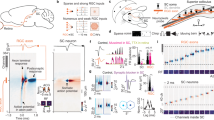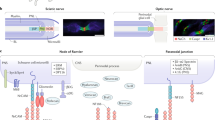Abstract
ALTHOUGH there have been several studies of internode length of myelinated fibres in peripheral nerve1,2 and in main fibre tracts of the central nervous system3,4, there has been only one report of internode lengths within neuropil and nuclear regions of the vertebrate central nervous systems (CNS)5. Internode lengths in uninjured peripheral nerves of fishes are always greater than 200 µm (ref. 1), and studies with rabbit spinal cord suggest that 200 µm is also a minimum periodicity in main fibre tracts of the CNS4. Bodian's study5 of internode lengths in CNS included obssrvations of myelinated fibres in the preoptic area, hypothalamus, hypoglossal root and pyramidal tract of the adult opossum. Of fifty-four fibres represented in his chart 1, six had internode lengths of approximately 100 µm or less; none had internode distances of less than 50 µm. During a study of the oculomotor nucleus of the spiny boxfish Chilomycterus with the electron microscope, I have made numerous observations of fine myelinated fibres with internodes less than 20 µm long and occasionally approximately 5 µm long. Tissue was fixed by perfusion with buffered solutions of osmium tetroxide or glutaraldehyde followed by osmium tetroxide and prepared for microscopy as reported before6.
This is a preview of subscription content, access via your institution
Access options
Subscribe to this journal
Receive 51 print issues and online access
$199.00 per year
only $3.90 per issue
Buy this article
- Purchase on Springer Link
- Instant access to full article PDF
Prices may be subject to local taxes which are calculated during checkout
Similar content being viewed by others
References
Thomas, P. K., and Young, J. Z., J. Anat., 83, 336 (1949).
Hursh, J. B., Amer. J. Physiol., 127, 131 (1939).
Hess, A., and Young, J. Z., Nature, 164, 490 (1949).
Hess, A., and Young, J. Z., Proc. Roy. Soc., B, 140, 301 (1952).
Bodian, D., J. Comp. Neurol., 94, 475 (1951).
Kriebel, M. E., Bennett, M. V. L., Waxman, S. G., and Pappas, G. D., Science, 166, 520 (1969).
Bodian, D., and Taylor, N., Science, 139, 330 (1963).
Khattab, F. I., Anat. Rec., 156, 91 (1966).
Bennett, M. V. L., Pappas, G. D., Ajure, E., and Nakajima, Y., J. Neurophysiol., 30, 180 (1967).
Bennett, M. V. L., Pappas, G. D., Giminez, M., and Nakajima, Y., J. Neurophysiol., 30, 236 (1967).
Waxman, S. G., Kriebel, M. E., Bennett, M. V. L., and Pappas, G. D., J. Cell Biol., 39, 140a (1968).
Rushton, W. A. H., J. Physiol., 115, 101 (1951).
Cragg, B. G., and Thomas, P. K., J. Physiol., 136, 606 (1957).
Author information
Authors and Affiliations
Rights and permissions
About this article
Cite this article
WAXMAN, S. Closely Spaced Nodes of Ranvier in the Teleost Brain. Nature 227, 283–284 (1970). https://doi.org/10.1038/227283a0
Received:
Issue Date:
DOI: https://doi.org/10.1038/227283a0
This article is cited by
-
Relations between axons and oligodendroglial cells during initial myelination. II. The individual axon
Journal of Neurocytology (1990)
-
Occurrence of long non-myelinated axonal segments intercalated in myelinated, presumably sensory axons: electron microscopic observations in the dog atrial endocardium
Journal of Neurocytology (1984)
-
Relative Conduction Velocities of Small Myelinated and Non-myelinated Fibres in the Central Nervous System
Nature New Biology (1972)
Comments
By submitting a comment you agree to abide by our Terms and Community Guidelines. If you find something abusive or that does not comply with our terms or guidelines please flag it as inappropriate.



